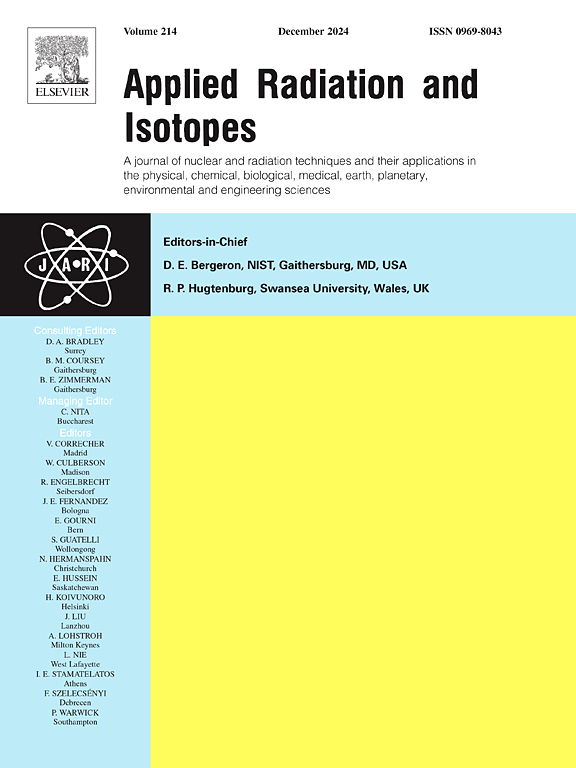Characterization of natural soda ash for dosimetry using thermoluminescence technique
IF 1.6
3区 工程技术
Q3 CHEMISTRY, INORGANIC & NUCLEAR
引用次数: 0
Abstract
Soda ash, due to its various use for industrial applications, is a phosphor likely to be found in the vicinities of radiation facilities where retrospective dosimetry may be required in the unlikely events of radiation accidents/incidents. The ash is therefore a potential material for retrospective dosimetry using luminescence techniques. In this report, the thermoluminescence characteristics of soda ash from Suan pan, Botswana are presented. The thermoluminescence glow curve of the soda ash consists three peaks near 79, 175 and 329 °C with a shoulder around 221 °C. The peak intensities of the peaks and the whole glow curve integrated intensity are linear with dose. Tm-Tstop analysis reveals soda ash contains four peaks near 82, 211, 235 and 335 °C. The four peaks are affected by thermal quenching with activation energy of thermal quenching 0.64 eV, 0.29 eV, 0.66 eV and 0.29 eV respectively. The intensities of the peaks decrease with optical stimulation. The minimum dose the phosphor can measure is evaluated to be 0.34 Gy. The thermoluminescence from soda ash is suitable for dosimetry, especially for high dose measurement. The peak near 335 °C with mean lifetime greater than 250 years is the most suitable for dosimetry. The phosphor may be able to produce phototransfer thermoluminescence.
用热释光技术表征天然纯碱的剂量学。
由于纯碱的各种工业用途,它是一种很可能在辐射设施附近发现的荧光粉,在不太可能发生的辐射事故/事件中,可能需要进行回顾性剂量测定。因此,灰是利用发光技术进行回顾性剂量测定的潜在材料。本文介绍了博茨瓦纳Suan pan纯碱的热释光特性。纯碱的热释光曲线在79、175和329℃附近有三个峰,在221℃附近有一个肩。各峰的峰值强度和整个发光曲线的综合强度与剂量成线性关系。Tm-Tstop分析显示纯碱在82、211、235和335°C附近含有四个峰。热淬火对4个峰的影响分别为0.64 eV、0.29 eV、0.66 eV和0.29 eV。峰的强度随光刺激而减弱。该荧光粉可测量的最小剂量经评估为0.34 Gy。纯碱热释光适用于剂量测定,特别是高剂量测定。在335°C附近,平均寿命大于250年的峰最适合用于剂量测定。该荧光粉可以产生光传递热释光。
本文章由计算机程序翻译,如有差异,请以英文原文为准。
求助全文
约1分钟内获得全文
求助全文
来源期刊

Applied Radiation and Isotopes
工程技术-核科学技术
CiteScore
3.00
自引率
12.50%
发文量
406
审稿时长
13.5 months
期刊介绍:
Applied Radiation and Isotopes provides a high quality medium for the publication of substantial, original and scientific and technological papers on the development and peaceful application of nuclear, radiation and radionuclide techniques in chemistry, physics, biochemistry, biology, medicine, security, engineering and in the earth, planetary and environmental sciences, all including dosimetry. Nuclear techniques are defined in the broadest sense and both experimental and theoretical papers are welcome. They include the development and use of α- and β-particles, X-rays and γ-rays, neutrons and other nuclear particles and radiations from all sources, including radionuclides, synchrotron sources, cyclotrons and reactors and from the natural environment.
The journal aims to publish papers with significance to an international audience, containing substantial novelty and scientific impact. The Editors reserve the rights to reject, with or without external review, papers that do not meet these criteria.
Papers dealing with radiation processing, i.e., where radiation is used to bring about a biological, chemical or physical change in a material, should be directed to our sister journal Radiation Physics and Chemistry.
 求助内容:
求助内容: 应助结果提醒方式:
应助结果提醒方式:


